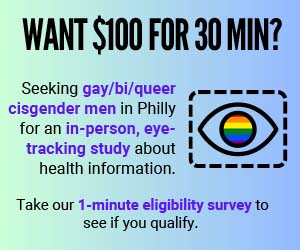Philadelphia is fortunate to be home to many agencies that provide holistic care aiming to meet the distinct needs of people living with HIV. These providers understand that comprehensive treatment means more than simply offering medical care, but also looking at the overall circumstances of a person’s life. Imagine if this comprehensive and patient-informed care model could be used not just to treat HIV, but to prevent HIV transmission completely.
That’s the impetus behind HIV Navigation Services at Mazzoni Center, part of a new program designed and funded by the Centers for Disease Control (CDC) that aims to reduce the amount of new HIV transmissions in Philadelphia and the surrounding areas.
The goals of this program are twofold: to support HIV-negative individuals at high risk of contracting HIV and to connect HIV-positive individuals to relevant care and resources.
“High risk” is a phrase often used when discussing sexual health, but it is rarely thoroughly defined or explained. When we talk about individuals being “high risk,” we are referring to persons who regularly engage in unprotected, penetrative anal or vaginal sexual intercourse; and/or persons who inject drugs, hormones, silicone or other substances using a shared needle. (Other methods of drug use that pose a risk include sharing a crack pipe that may pass blood from one user’s mouth into an open wound on the other.)
Such actions are considered high risk because they facilitate contact between some very specific bodily fluids of one person and a mucous membrane or open wound of the other. That contact is the only way that HIV can be transmitted, and there are only five bodily fluids that can contain HIV: blood, semen/pre-cum, vaginal fluid, anal fluid and breastmilk.
The problem with using “high risk” as a term, without additional context, is that it tends to place people into a category without regard for any mitigating circumstances — such as access to stable housing, education, safe and steady employment and affordable, quality health care — that may be preventing them from reducing their HIV risk.
On paper, the goal of Navigation Services is defined in numbers: If we can successfully engage with high numbers of people, connecting them to the kinds of support they need to stay healthy, we can point to far-lower numbers of people acquiring HIV in the future.

The process of using data to develop programs like ours is necessary and essential. But the language we use sometimes feels like it takes away personhood from the individual and unintentionally changes them into a statistic.
We are here to serve the people represented by all of those numbers — each of whom has an individual story and set of circumstances that we need to acknowledge and understand in order to provide them with the right kind of support.
For both providers and clients, it can feel like a monotonous, frustrating battle to work within a machine that accepts complex input and expects simple output. Thirty years into the HIV/AIDS epidemic, the overall outlook has dramatically improved, but too many people continue to face barriers to accessing resources and achieving outcomes we know are possible. Through Navigation Services, we hope to help more people surmount those barriers.
We are at a point where an HIV-positive person can, with proper medical treatment and care, achieve an “undetectable viral load” — where the body is battling the HIV virus so effectively, only a minimal amount remains in their system.
Today we have a medication known as PrEP that has been shown to be 99.9-percent effective in preventing the transmission of HIV. For folks who are negative, and who may be at “high risk” for whatever reason, this is a truly groundbreaking option to have.
We need to remind ourselves how important and life-altering these treatment options are, and how frustratingly inaccessible the process of obtaining quality, comprehensive, patient-informed care can be for many, even in 2016. The role of Navigation Services is to change that, to create access for as many people as possible, to lift people up.
Maybe you would like to get PrEP but your current provider, for whatever reason, won’t prescribe it. We can help. Maybe your fear of HIV has impacted your intimate relationships, and your life could be changed with knowledge about and access to the right resources. We’re here for you. If you have never felt welcomed or affirmed by the health-care system, or if you just need help in taking that first step, you are the person we’re here for and ready to work with.
Health is complicated, but working toward it doesn’t need to be.
Contact us at [email protected] or 215-563-0652 ext. 435.
Note: The Navigation team can provide services in Spanish and American Sign Language. Other translation/interpretation options can be arranged.